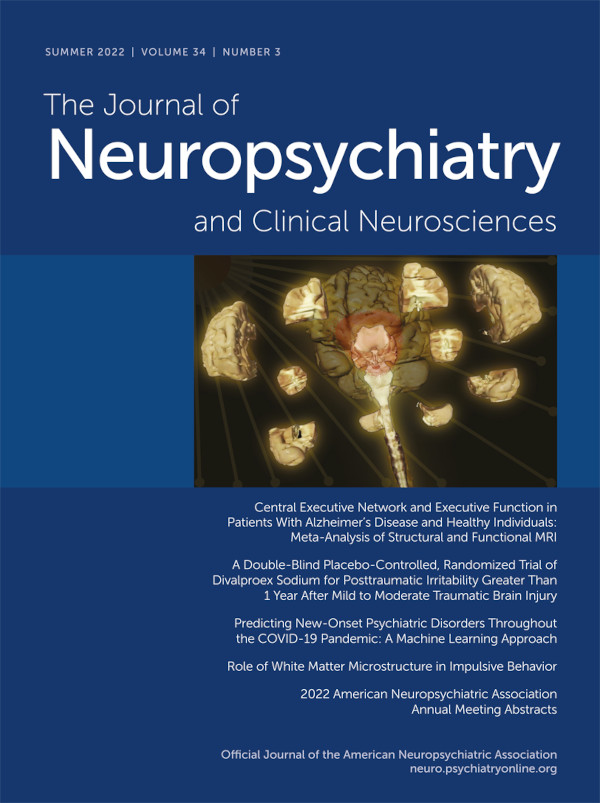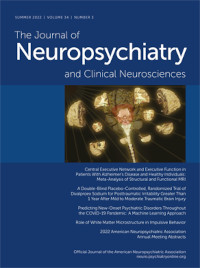TO THE EDITOR: The journal published an intriguing article titled “Predisposing Risk Factors for Functional Limb Weakness: A Case-Control Study,” by Stone and colleagues (
1), in which significant associations between functional limb weakness and several potential vulnerability factors were documented. We would like to comment on the association of hysterectomy with functional neurological disorder (FND).
As described by Stone and colleagues, the association can be explained by a more general tendency to undergo surgical procedures (such as an appendectomy or cholecystectomy). This tendency might originate from a hope to get relief from symptoms that cannot be understood from a somatic perspective. We would like to add another hypothesis regarding a moderating factor that could possibly explain the elevated prevalence of a history of hysterectomy among patients with FND: hormones.
The main reason for the hysterectomies among the patients studied by Stone and colleagues is unknown. Another study (
2), in which a similar association was observed among 272 women admitted to a neurology department, may shed light on the causes: among women discharged with no objective neurologic findings (mostly headaches and neurological complaints concerning the extremities), the frequency of hysterectomy was 13.9% (N=25), compared with 5.4% (N=5) (p<0.05) among women discharged with a diagnosis indicating organic neurologic disease. The main indications for hysterectomy in the group without objective neurological findings were pain, irregular bleeding, and dyspareunia. Possibly, a similar indication pattern was the reason for hysterectomy among the patients studied by Stone and colleagues.
Psychological distress influences hormonal systems via hypothalamic activity. This can influence menstruation. The womb itself does not produce any hormones. Stress influences hypothalamic activity, and thus it influences the hypothalamic-pituitary-adrenal axis, hypothalamic-pituitary-gonadal axis, and hypothalamic-pituitary-thyroidal axis (
3). Through these pathways, stress can induce hormonal disbalances. Hormonal disbalance can subsequently cause dysmenorrhea or metrorrhagia (
4). This dysmenorrhea and metrorrhagia may pave the way for hysterectomy as a potential solution. If the stress continues, hypothetically, FND may develop.
The role of hypothalamus-pituitary-related hormones in FND is complicated given the various hormonal feedback loops. This complexity is evident in a case report of a 20-year-old woman with psychogenic nonepileptic seizures, a form of FND, who appeared to have late-onset congenital adrenal hyperplasia (
5). Her dehydroepiandrosterone sulfate (DHEAS) level was 3,640 ng/ml (normal reference values: 800–3300 ng/ml), and her cortrosyn stimulation showed an eightfold elevation of 17-hydroxyprogesterone, from a baseline level of 48 ng/dl to a 60-minute level of 393 ng/dl (normal range: 20–100 ng/dl). She was treated with ketoconazole, a steroid synthesis-blocking agent (200 mg, 0.5-tablet three times daily), which was associated with normalization of her serum DHEA levels and a reduction of her seizure episodes from six per month to two or three each year during more than 2 years of follow-up. DHEAS is hormonally inert, but it is a neurosteroid that modulates several receptors in the brain and hence is potentially relevant to the etiology of FND.
Other indicators for a mediating role of hormones in the association between hysterectomy and FND are found in case reports about FND and gynecological surgery (
6), as well as about FND and psychogenic seizures disappearing during pregnancy (
7) or starting after pregnancy termination (
8).
Associations between hysterectomy, irregular bleeding, and hormonal factors are also observed in our Center of Excellence for Body, Mind and Health. For example, an 18-year-old patient who had had FND for approximately 3 years asked whether her symptoms could be caused by the contraception (ethinylestradiol/levonorges, 0.02/0.1 mg) that she started to use before the onset of her symptoms. After consultation, the patient decided to discontinue the oral contraceptives, and 3 weeks later she reported that almost all of her symptoms had disappeared. At a follow-up after 4 months, almost all of her symptoms were still resolved. The patient was not open for a rechallenge with the contraceptive to see whether her symptoms would return.
These observations indicate that more research is needed to explore both hypotheses for the association between hysterectomy with FND. Is there a higher rate of hysterectomies among FND patients, as they seek relief from medically unexplained symptoms, and/or are there any hormonal factors that contribute to the development of FND?

